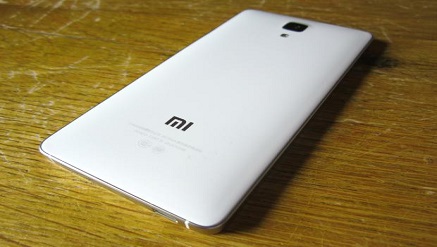Telecom
Xiaomi Mi4 Built With Incredible Power, Fast Software

The Xiaomi Mi4 is one of the biggest handset releases in Nigeria in 2015 and deserves testing one out.
Here is the experience you are going to get upon using the smartphone:
Up: Xiaomi Mi4 proves to be amazingly built with quality, fast software, excellent hardware and pocket-friendly.
Down: It is unbelievable that Xiaomi Mi4 has no Micro SD card slot; showing that the design is a clear imitation of the iPhone.
Design & Display (DD)
The Mi4 come with a metal chassis fronted by a Gorilla Glass screen and backed with a plastic rear panel. Along the bottom you’ll find a single speaker and again looking like the one seen on the iPhone 5.
The device uses MicroUSB-B, a clear departure from what “regular” smartphones use which is MicroUSB-A.
The USB-B connection will still fit, however, but there’s the added danger of inserting it upside down here.
Sleek phones loving Nigerians will definitely find a “companion” in Xiaomi Mi4, especially for it semblance with iPhone.
The hardware (body) build quality is fantastic, and the use of metal equates the smartphone to a standard not usually associated with Android arena.
The 5in IPS display is also striking and very impressive, sporting a full HD 1080 x 1920 pixel resolution and rock-solid viewing angles.
Interestingly, the display is easily seen in direct sunlight, and boasts the kind of colour replication you’d expect from a top of the line handset.
Hardware and Performance (HP)
While the Xiaomi Mi4’s price may be well below what you’d pay for an iPhone 6 or Galaxy S5 –– in Nigeria, of course, it retails for less than N50,000.
Mi4 has some elegant specifications, including a quad-core Snapdragon 801 chipset clocked at 2.5GHz. That’s backed by 3GB of RAM, all of which provides a silky-smooth user experience and amazing performance when playing 3D games.
The 3G unit we reviewed comes with 16GB of storage while the 4G unit has 64 gigabytes .
It’s worthy of note that there is no way to add in more storage using Micro SD cards, so you’ll have to choose wisely if you like downloading lots of content.
Also, NFC is also missing, which iis not pleasant when you consider that the tech is likely to take off in a big way now that Apple is officially supporting it with its new iPhone models.
Software (MIUI)
Xiaomi’s MIUI (pronounced, “Me-You-Eye”) is snap on Android.
In the case of MIUI 5, which ships with the Mi4, it’s built on Android 4.3.
However, unlike other manufacturers Xiaomi has been quite aggressive with its UI skin.
Unlike to a Western user who may not enjoy not Google apps, largely because Android phones sold in China rarely come with such software pre-installed, Nigerians can (though a Google Installer application) load up everything you need, from Gmail to Google Play.
While MIUI 5 was the OS that shipped with the device reviewed, it is upgradable to MIUI 6 (based on Android 4.4), which isn’t officially available as yet but can easily be flashed to the phone using a dedicated application.
Another feature of MIUI that makes it feel like iOS is the lack of an app drawers. Of course, all time Android fans may find it hard to get adapt. But, you can still use widgets as normal.
There is minor change on the MIUI based as the notification bar at the top of the screen no longer displays any icons, and instead you have to slide down the notification panel to see what messages you have.
The challenge is the possible of one often missing notifications or ignored them purely because they didn’t flash up in the bar.
But, designers at Mi are smart enough to compensate. Thus, notifications now pop up at the top of the screen no matter what activity you’re involved in –– just like they do in iOS.
MIUI 6 are very cool; coming with “Do Not Disturb” option built into the OS itself, and there are little customizations to play around with, including a menu which allows you to control the colour temperature of the screen.
Most of all though, MIUI is fast; perhaps not as swift as stock Android on a Nexus 5, but certainly meets the fancy.
Battery and Camera (BC)
The Mi4 has a large 3080mAh battery, and edges of the in the Galaxy S5 in terms of size. It seems there is behind the scenes operations that ensure the Mi4 lasts longer than most of its big-screen rivals.
This is because, it lasts almost three entire days out of the pphone. This has not been the case with an Android phone for some time now.
It’s actually possible to select from different battery profiles, but most interesting to us is the “Balanced” mode that left most features running and intact, presumably dialing down the Snapdragon 801 chipset in order to save on the juice. Regardless of what tactics Xiaomi is adopting to preserve battery life, the Mi4’s stamina supercede others of same status.
Xiaomi Mi4 brandished its Sony-made 13MP camera and that is equally impressive.
It offers excellent picture quality and fast focus times. The Mi4 is capable of producing some spectacular images, even if it does occasionally struggle with high-contrast areas.
Verdict
Xiaomi understands that iPhone hasn’t made significant inroads to Nigeria, which might have spurred it to through up the “iPhone of China” into the market late last year.
However, and with its incredible power and a gorgeous design; making it one of the best phones of 2015 (in Nigeria) , as long as you can put up with snatches of Chinese text, there are drawbacks also. Without Micro SD card slot being possibly the most obvious and the lack of 4G in this launch model is also an issue.
Not including NFC seems very shortsighted by Xiaomi.
Nonetheless, it is worth putting up with due to the speed and the design being the most aesthetically pleasing Android handsets in the market now.
Telecom
ngCERT Issues High Alert to Nigerians Using Android Phones

Nigeria Computer Emergency Response Team (ngCERT) has raised alarms over a new wave of advanced cyberattacks targeting Android mobile phones through a malware campaign dubbed Tria Stealer.

The malicious software is designed to infiltrate Android devices, hijack messaging accounts, intercept One-Time Passwords (OTPs), to steal sensitive personal and financial data.
According to ngCERT, Tria Stealer spreads primarily through deceptive tactics, such as fake event invitations distributed via popular messaging platforms like WhatsApp and Telegram.
Unsuspecting users are enticed to download an infected (APK) file, often disguised as a harmless system application, to evade detection.
Once installed, Tria Stealer requests extensive permissions, including access to SMS, call logs, and app notifications.
It immediately commences data harvesting activities, sending stolen information to a Command and Control (C2) server operated via Telegram bots.
This trojan spreads through fake links, usually disguised as wedding or event invites, and tricks users into downloading malicious APK files
“Account takeover of messaging platforms. Impersonation of victim for fraudulent money transfer requests. Compromise of banking and financial applications. Identity theft and credential harvesting.”
In plain terms, if your phone is compromised, the consequences could be catastrophic.
Your financial apps are vulnerable, your reputation could be ruined by impersonation and even simple personal messages could be twisted into tools for scams.
Here’s what users should be doing now:
Don’t download apps outside the official Play Store.
Be suspicious of random invites or links, even from people you know.
Turn on 2FA for everything—banking, emails, social platforms.
Get a reputable antivirus and keep it updated.
If you run an organisation, you should already be taking this seriously.
ngCERT’s guidance says you should raise awareness, monitor mobile devices, and not let your team click on unverified links.
“Deploy network monitoring for suspicious outbound connections to known C2 domains,” it said, meaning, keep an eye on every digital door in and out.
This isn’t one of those cases where you wait to see if it affects you. By the time you realise it, it may already be too late.
Telecom
MTN and Ecobank Launch Chess Championship to Empower Nigeria’s Youth

MTN Nigeria is set to host the National Schools Team Chess Championship, Nigeria’s largest inter-school chess competition, scheduled to take place from June 26th to 28th, 2025, at the Ecobank Pan African Center in Victoria Island, Lagos.

The championship, organised in partnership with Ecobank and the Nigeria Chess Federation (NCF), aims to promote intellectual development, critical thinking, and problem-solving skills among young Nigerians, while also identifying and nurturing future chess champions.
The championship is open to primary, secondary, and tertiary level students, and this year’s edition will host an impressive 1,600 students from 400 schools across 36 states and the FCT.
The competition will feature team-based play, with each team comprising four players from the same school. A significant prize pool of over N40 million is at stake, with winning schools also having the invaluable opportunity to represent Nigeria internationally.
Onyinye Ikenna Emeka, Chief Marketing Officer (CMO) at MTN Nigeria, expressed the company’s commitment to the initiative, stating, “Our investment is driven by our commitment to fostering youth development, just as our shared value initiative.
“By supporting, we not only contribute to the growth but also engage with the younger demographic in a meaningful way, as we believe we are good together”.
MTN’s sponsorship of the National Schools Team Chess Championship is a natural extension of its long-standing dedication to empowering young people through various initiatives in sports, education, and skill development, including programs like MTN Champs and MTN Campus Invasion.
The company aims to establish itself as the leading driver of youth empowerment, education, and strategic thinking through chess in Nigeria.
The event will also feature the presence of Tunde Onakoya, a renowned chess master and inspiration, who will join the championship week to share his experiences and further inspire the young participants.
His involvement underscores the profound impact strategic thinking can have on transforming lives and building dreams.
Telecom
NCC and Stakeholders Unite to Bridge Nigeria’s Rural Connectivity Gap

Nigerian Communications Commission (NCC) has collaborated with the Association for Progressive Communications and other institutional stakeholders towards addressing challenges confronting rural network connectivity in Nigeria.

The collaboration resulted in a two-day workshop hosted in Abuja from June 3-4, 2025, to explore policy framework for enabling community networks towards bridging the digital divide and accelerating socio-economic development in Nigeria’s underserved and unserved communities.
The forum brought together regulators, community leaders, technical experts and potential foreign investors, among others, to examine policy and regulatory barriers, explore innovative funding mechanisms, ensure sustainable renewable solutions and strengthen collaboration with stakeholders.
Addressing participants at the workshop, the Executive Vice Chairman of NCC, Dr. Aminu Maida, said the workshop is important to bridging the digital divide in Nigeria and foster inclusive social economic development.
“This workshop is an opportunity for all of us to harness the expertise, insights, and experiences of diverse stakeholders present here which includes the regulators, community leaders, technical experts and potential foreign providers to address the critical challenges such as affordable devices, access, licensing, spectrum allocation, infrastructure development, sustainability and institutional monitoring,” said Maida, who was represented by the Executive Commissioner, Technical Services, NCC at the event, Abraham Oshadami.
Maida said the workshop demonstrates the Commission’s commitment to advancing digital inclusion, particularly in underserved and unserved areas. “At NCC, we recognise the transformative potential of community center networks in achieving this important goal,” he said.
The EVC said NCC was committed to “this journey and views this workshop as a catalyst for meaningful change,” stating that the expertise, perspectives and commitments will shape the future where every Nigerian, regardless of his or her status, will have meaningful access to opportunities from digital connectivity.
In her remarks, Co-manager of the Association for Progressive Communications’ Local Network (LocNet) initiative, Kathleen Diga, noted that the collaboration was to tackle identified hindrances to digital inclusion. “This is a space where we can be open and exchange ideas of possibilities, opportunities that will remain in realising values of a diversified ecosystem.”
Diga said, “I believe this workshop presents a moment in time that we can explore the bottom-up approach in local communities, small social enterprises, corporative among others, which have the ability to fill some of the digital gaps that remain unfilled,” she said, adding emphasising the need to recognise that community centre connectivity exists and they are grow throughout the global south, which, she said, are a “strategic response to digital exclusion.”
The workshop featured presentations from the NCC, the Association for Progressive Communications and other institutional stakeholders such as the Rural Electrification Agency (REA) and the Central Bank of Nigeria (CBN) all geared towards exploring a joint policy framework to address rural digital divide.
The Association for Progressive Communications is a 35-year-old international network member-based organisation encouraging digital inclusion in the unserved communities, particularly with communities in the global south and the workshop, through its LocNet initiative aimed at crafting an enabling inclusive regulatory framework for community networks in Nigeria.

 Telecom2 days ago
Telecom2 days agoTelcos Hit by Major Outages across Lagos, Enugu, Others

 E-Business2 days ago
E-Business2 days agoHuman Hacking: When Cyber Criminals Target You

 News2 days ago
News2 days agoBeware!, Fraudsters Using our Name to Defraud Investors- NNPCL

 E-Financial2 days ago
E-Financial2 days agoAGF Drops Charges Against Fidelity Bank MD, Cites Lack of Direct Involvement

 E-Financial2 days ago
E-Financial2 days agoFIRS Launches Revised SOP to Streamline Tax Payment

 News2 days ago
News2 days agoFG Plans AgriConnect Initiative Pilot

 E-Financial2 days ago
E-Financial2 days agoConfidence in Nigerian Economy Grows as Forex Inflows Reach $5.96Bn

 News2 days ago
News2 days agoAAAN Congratulates Steve Babaeko, X3M Ideas on Financial Times Recognition
















